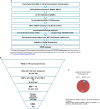Whole-genome sequencing reveals de-novo mutations associated with nonsyndromic cleft lip/palate
- PMID: 35817949
- PMCID: PMC9273634
- DOI: 10.1038/s41598-022-15885-1
Whole-genome sequencing reveals de-novo mutations associated with nonsyndromic cleft lip/palate
Abstract
The majority (85%) of nonsyndromic cleft lip with or without cleft palate (nsCL/P) cases occur sporadically, suggesting a role for de novo mutations (DNMs) in the etiology of nsCL/P. To identify high impact protein-altering DNMs that contribute to the risk of nsCL/P, we conducted whole-genome sequencing (WGS) analyses in 130 African case-parent trios (affected probands and unaffected parents). We identified 162 high confidence protein-altering DNMs some of which are based on available evidence, contribute to the risk of nsCL/P. These include novel protein-truncating DNMs in the ACTL6A, ARHGAP10, MINK1, TMEM5 and TTN genes; as well as missense variants in ACAN, DHRS3, DLX6, EPHB2, FKBP10, KMT2D, RECQL4, SEMA3C, SEMA4D, SHH, TP63, and TULP4. Many of these protein-altering DNMs were predicted to be pathogenic. Analysis using mouse transcriptomics data showed that some of these genes are expressed during the development of primary and secondary palate. Gene-set enrichment analysis of the protein-altering DNMs identified palatal development and neural crest migration among the few processes that were significantly enriched. These processes are directly involved in the etiopathogenesis of clefting. The analysis of the coding sequence in the WGS data provides more evidence of the opportunity for novel findings in the African genome.
© 2022. The Author(s).
Conflict of interest statement
The authors declare no competing interests.
Figures




Similar articles
-
Prioritization of non-coding elements involved in non-syndromic cleft lip with/without cleft palate through genome-wide analysis of de novo mutations.HGG Adv. 2022 Dec 5;4(1):100166. doi: 10.1016/j.xhgg.2022.100166. eCollection 2023 Jan 12. HGG Adv. 2022. PMID: 36589413 Free PMC article.
-
[Exploring the association between de novo mutations and non-syndromic cleft lip with or without palate based on whole exome sequencing of case-parent trios].Beijing Da Xue Xue Bao Yi Xue Ban. 2022 Jun 18;54(3):387-393. doi: 10.19723/j.issn.1671-167X.2022.03.001. Beijing Da Xue Xue Bao Yi Xue Ban. 2022. PMID: 35701113 Free PMC article. Chinese.
-
Target Capture/Next-Generation Sequencing for Nonsyndromic Cleft Lip and Palate in the Japanese Population.Cleft Palate Craniofac J. 2020 Jan;57(1):80-87. doi: 10.1177/1055665619857650. Epub 2019 Jul 23. Cleft Palate Craniofac J. 2020. PMID: 31337262
-
Genome-wide Enrichment of De Novo Coding Mutations in Orofacial Cleft Trios.Am J Hum Genet. 2020 Jul 2;107(1):124-136. doi: 10.1016/j.ajhg.2020.05.018. Epub 2020 Jun 22. Am J Hum Genet. 2020. PMID: 32574564 Free PMC article.
-
Association between the IRF6 rs2235371 polymorphism and the risk of nonsyndromic cleft lip with or without cleft palate in Chinese Han populations: A meta-analysis.Arch Oral Biol. 2017 Dec;84:161-168. doi: 10.1016/j.archoralbio.2017.09.032. Epub 2017 Oct 2. Arch Oral Biol. 2017. PMID: 29017114 Review.
Cited by
-
Divergent growth of the transient brain compartments in fetuses with nonsyndromic isolated clefts involving the primary and secondary palate.Cereb Cortex. 2024 Jan 31;34(2):bhae024. doi: 10.1093/cercor/bhae024. Cereb Cortex. 2024. PMID: 38365268 Free PMC article.
-
Meta-analysis reveals transcription factors and DNA binding domain variants associated with congenital heart defect and orofacial cleft.medRxiv [Preprint]. 2025 Feb 2:2025.01.30.25321274. doi: 10.1101/2025.01.30.25321274. medRxiv. 2025. PMID: 39974057 Free PMC article. Preprint.
-
Force Field X: A computational microscope to study genetic variation and organic crystals using theory and experiment.J Chem Phys. 2024 Jul 7;161(1):012501. doi: 10.1063/5.0214652. J Chem Phys. 2024. PMID: 38958156 Free PMC article.
-
Clinically actionable secondary findings in 130 triads from sub-Saharan African families with non-syndromic orofacial clefts.Mol Genet Genomic Med. 2023 Oct;11(10):e2237. doi: 10.1002/mgg3.2237. Epub 2023 Jul 26. Mol Genet Genomic Med. 2023. PMID: 37496383 Free PMC article.
-
Identification of RESP18 Gene Mutations Linked to Hereditary Non-Syndromic Cleft Lip and Palate in a Southern Chinese Family.Med Sci Monit. 2024 Jul 6;30:e944294. doi: 10.12659/MSM.944294. Med Sci Monit. 2024. PMID: 38970244 Free PMC article.
References
Publication types
MeSH terms
Supplementary concepts
Grants and funding
LinkOut - more resources
Full Text Sources
Medical
Miscellaneous

